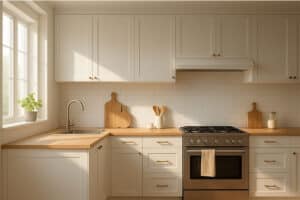Kitchen Design Ideas – Not all kitchen sinks are created equal. Choosing the right material can make a significant difference in both style and practicality—especially in Indian kitchens, were cooking demands durability and functionality. This guide will help you navigate the best kitchen sink materials tailored for everyday use, aesthetic appeal, and long-term performance.
When designing or renovating a kitchen, the sink is often overlooked in favor of cabinets or countertops. However, it plays a central role in daily tasks—from rinsing vegetables to scrubbing heavy cookware. The material you select impacts not only the visual appeal of your kitchen but also how well your sink handles wear and tear over time.
In the sections ahead, we’ll explore the most popular kitchen sink materials, highlight their advantages and limitations, and help you identify which one best suit your cooking habits, lifestyle, and design goals. Let’s dive in!
5 Common Kitchen Sink Materials Used in Homes
- Stainless Steel: Reliable and Budget-Friendly Sink Material
Stainless steel remains one of the most popular kitchen sink materials in Indian households—and for good reason. It offers a winning combination of affordability, durability, and low maintenance. Ideal for busy families who cook frequently, stainless steel sinks maintain a clean, modern appearance while standing up to everyday use.
However, there are a few considerations to keep in mind. Stainless steel sinks can be somewhat noisy, and thinner models may be prone to dents and scratches. To enhance durability and minimize noise, it’s wise to choose a thicker gauge—typically 16 or 18 gauge—for a longer-lasting and more resilient sink.
- Granite Composite: A Durable and Elegant Type of Kitchen Sink Material
Rapidly gaining popularity in modern modular kitchens, composite sinks—typically made from a blend of granite or quartz and resin—are known for their stylish matte finish and exceptional resistance to stains, scratches, and heat. They are an excellent choice for contemporary homes seeking a balance between aesthetic appeal and long-term durability.
That said, composite sinks tend to be heavier and more costly than traditional options. As a result, they require sturdy countertop support and careful installation to ensure lasting performance.
- Fireclay Tops the List of Unique Kitchen Sink Materials
For those who admire vintage or farmhouse-style kitchens, fireclay sinks are a timeless choice. Made from molded ceramic and finished with a high-gloss glaze, these sinks offer a smooth, elegant surface that resists chips, stains, and discoloration. Their glossy finish adds a refined charm to both traditional and transitional kitchen designs.
While fireclay sinks tend to be on the higher end of the price spectrum, their durability and aesthetic appeal make them a worthwhile investment. Due to their weight and size, professional installation is often recommended to ensure proper support and a flawless fit.
- Marble: A Kitchen Sink Material with an Old-School Charm
Marble sinks bring timeless elegance and robust strength, making them a stunning addition to traditional or vintage-style kitchens. Their natural veining and classic appeal can elevate the overall aesthetic of the space.
However, marble is a heavy material and can be prone to chipping if heavy cookware is dropped on it. While not ideal for every kitchen—especially high-traffic or family-heavy ones—marble sinks are still worth considering for homeowners who prioritize style and are prepared to handle the additional care they require.
- Quartz Composite: Sleek, Sturdy, and Modern Sink Material
Quartz sinks are quickly establishing themselves as a modern kitchen essential. Crafted from natural quartz stone blended with resin, these sinks offer a non-porous, stain-resistant surface that stands up well to daily wear and tear. Their sophisticated matte finish pairs beautifully with both minimalist and upscale kitchen design ideas.
However, due to their substantial weight, quartz sinks require proper countertop support during installation. Ensuring adequate structural reinforcement will help prevent potential damage and ensure long-term performance.
Kitchen Design Ideas – Factors to Consider Before Choosing Your Kitchen Sink Material
Selecting the right kitchen sink material goes beyond aesthetics. It’s essential to consider how your kitchen is used, who’s using it, and how much time you’re willing to dedicate to upkeep. A well-chosen sink enhances both functionality and long-term satisfaction.
Here are some key factors to keep in mind:
- Cooking Habits:
If your cooking frequently involves frying, spices, or heavy oil use, choose a material that’s easy to clean and resistant to stains—such as stainless steel or quartz composite.
- Kitchen Style:
For sleek, modern kitchen design, stainless steel is a go-to option. If you’re designing a more premium or designer space, fireclay or quartz offers a more refined look.
- Maintenance:
Prefer a low-maintenance lifestyle? Steer clear of materials that require frequent polishing or deep cleaning. Quartz and stainless steel are excellent low-maintenance choices.
- Budget:
Stainless steel provides great performance at an affordable price point. Granite composite, quartz, and fireclay, while more expensive, offer added durability and visual appeal.
- Countertop Support:
Heavy sink materials like quartz, fireclay, or cast-iron need solid countertop support. Ensure your counter structure can handle the weight to avoid long-term issues.
Kitchen Sink Materials Pros and Cons You Should Know
These pros and cons help you pick a sink that works for your family, cooking habits, and interior style.
| Material | Pros | Cons |
|---|---|---|
| Stainless Steel | Easy to clean, rust-resistant, and affordable | Prone to scratches and water spots |
| Granite Composite | Beautiful, stain- and scratch-resistant | Heavy and more expensive |
| Fireclay | Glossy, has a high-end look, chip-resistant | Heavy and requires professional installation |
| Marble | Durable, traditional look, long-lasting | Can chip; very heavy |
| Quartz | Non-porous,low-maintenance, elegant | Requires solid counter support, premium price |
Conclusion
There’s no one-size-fits-all solution when it comes to kitchen sinks. For high-traffic or family-focused kitchens, durable options like stainless steel or composite materials offer the best practicality. On the other hand, if you’re designing a statement kitchen that prioritizes elegance, investing in fireclay or quartz may be the right choice. Ultimately, the key is to find the right balance between functionality, aesthetics, and budget.
Still unsure which sink material best suits your space? The experts at ARC Cabinetry are here to help. Schedule a free consultation and let us guide you through your kitchen transformation—with solutions tailored to your lifestyle and design goals.
FAQs
What are the different types of kitchen sink materials available?
A variety of kitchen sink materials are available to suit different design preferences and functional needs. The most popular options include stainless steel, granite composite, fireclay, cast iron, and quartz. Each material offers a distinct combination of durability, maintenance requirements, and visual appeal—allowing you to choose one that aligns best with your kitchen style and daily usage.
What is the most durable kitchen sink material?
Granite composite and quartz are considered among the most durable kitchen sink materials available. Both are highly resistant to heat, stains, and scratches, making them well-suited for the demands of busy Indian kitchens. Their long-lasting performance and low maintenance make them a smart investment for everyday use.
What is the easiest kitchen sink material to clean and maintain?
Stainless steel and quartz sinks are among the easiest to clean and maintain. Both materials are non-porous, resist staining, and require minimal upkeep—no need for special cleaners or frequent polishing. Their hassle-free maintenance makes them ideal for everyday use in busy kitchens.
How does the sink material impact the overall look and style of my kitchen?
The material of your kitchen sink significantly influences both the visual appeal and design harmony of the space. For example, stainless steel offers a sleek, modern look that suits minimalist and industrial-style kitchens. In contrast, fireclay or quartz sinks bring a more refined, upscale feel—ideal for contemporary or luxury interiors. Depending on the finish and texture, your sink can seamlessly blend with the surroundings or serve as a bold focal point within the kitchen design ideas.





